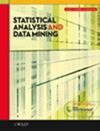用于整合和分析多平台高维基因组学数据的贝叶斯收缩模型
IF 2.1
4区 数学
Q3 COMPUTER SCIENCE, ARTIFICIAL INTELLIGENCE
引用次数: 0
摘要
随着临床研究中来自多个平台的同一患者的生物医学数据(如表观基因组学、基因表达和临床特征)越来越多,人们越来越需要能够联合分析不同平台数据的统计方法,为临床研究提供互补信息。在本文中,我们提出了一种两阶段分层贝叶斯模型,该模型可整合来自不同平台的高维生物医学数据,从而筛选出与临床结果相关的生物标记物。在第一阶段,我们使用基于期望最大化的方法来学习表观基因组学(如基因甲基化)和基因表达之间的调控机制,同时考虑功能基因注释。在第二阶段,我们根据第一阶段学习到的调控机制对基因进行分组。然后,我们在结合临床特征的同时,应用分组惩罚来选择与临床结果显著相关的基因。模拟研究表明,与现有方法相比,我们基于模型的数据整合方法在选择预测变量时误报率较低。此外,基于胶质母细胞瘤(GBM)数据集的真实数据分析显示,与现有方法相比,我们的方法具有更高的准确性,可以检测出与胶质母细胞瘤存活率相关的基因。此外,现有文献证实,所选的大多数生物标志物对 GBM 的预后至关重要。本文章由计算机程序翻译,如有差异,请以英文原文为准。
Bayesian shrinkage models for integration and analysis of multiplatform high‐dimensional genomics data
With the increasing availability of biomedical data from multiple platforms of the same patients in clinical research, such as epigenomics, gene expression, and clinical features, there is a growing need for statistical methods that can jointly analyze data from different platforms to provide complementary information for clinical studies. In this paper, we propose a two‐stage hierarchical Bayesian model that integrates high‐dimensional biomedical data from diverse platforms to select biomarkers associated with clinical outcomes of interest. In the first stage, we use Expectation Maximization‐based approach to learn the regulating mechanism between epigenomics (e.g., gene methylation) and gene expression while considering functional gene annotations. In the second stage, we group genes based on the regulating mechanism learned in the first stage. Then, we apply a group‐wise penalty to select genes significantly associated with clinical outcomes while incorporating clinical features. Simulation studies suggest that our model‐based data integration method shows lower false positives in selecting predictive variables compared with existing method. Moreover, real data analysis based on a glioblastoma (GBM) dataset reveals our method's potential to detect genes associated with GBM survival with higher accuracy than the existing method. Moreover, most of the selected biomarkers are crucial in GBM prognosis as confirmed by existing literature.
求助全文
通过发布文献求助,成功后即可免费获取论文全文。
去求助
来源期刊

Statistical Analysis and Data Mining
COMPUTER SCIENCE, ARTIFICIAL INTELLIGENCEC-COMPUTER SCIENCE, INTERDISCIPLINARY APPLICATIONS
CiteScore
3.20
自引率
7.70%
发文量
43
期刊介绍:
Statistical Analysis and Data Mining addresses the broad area of data analysis, including statistical approaches, machine learning, data mining, and applications. Topics include statistical and computational approaches for analyzing massive and complex datasets, novel statistical and/or machine learning methods and theory, and state-of-the-art applications with high impact. Of special interest are articles that describe innovative analytical techniques, and discuss their application to real problems, in such a way that they are accessible and beneficial to domain experts across science, engineering, and commerce.
The focus of the journal is on papers which satisfy one or more of the following criteria:
Solve data analysis problems associated with massive, complex datasets
Develop innovative statistical approaches, machine learning algorithms, or methods integrating ideas across disciplines, e.g., statistics, computer science, electrical engineering, operation research.
Formulate and solve high-impact real-world problems which challenge existing paradigms via new statistical and/or computational models
Provide survey to prominent research topics.
 求助内容:
求助内容: 应助结果提醒方式:
应助结果提醒方式:


